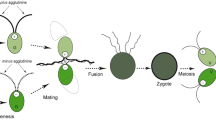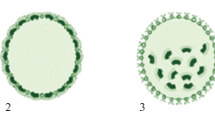Summary
Sexual induction in the ‘Gone 12’ mutant of Volvox carteri can be achieved by shortterm treatment with glutardialdehyde or formaldehyde, followed by capture of the aldehyde by means of amino acids at slightly acidic pH. The same effect is obtained by exposure to anthranilic acid formalide, the condensation product of 2-amino benzoic acid with formaldehyde, at low concentration for several minutes. This is in contrast to the prolonged exposure required by the specific glycoprotein inducer. In both situations the asexual reproductive cells are affected in such a way that they change their pattern of cleavage to form sexual embryos rather than asexual ones. Thus, besides the natural messenger molecule, a physical (UV light, heat) or molecular shock may trigger the chain reaction leading to expression of sexual induction.
Similar content being viewed by others
References
Beilstein's Handbook of Organic Chemistry (1937) 4th edn, vol XXVII. Springer, Berlin, p 189
Callahan AM, Huskey RJ (1980) Genetic control of sexual development in Volvox. Dev Biol 80:419–435
Gilles R, Jaenicke L (1982) Differentiation in Volvox carteri: study of pattern variation of reproductive cells. Z Naturforsch 37C:1023–1030
Gilles R, Gilles C, Jaenicke L (1983) Sexual differentiation of the green alga Volvox carteri. Naturwissenschaften 70:571–572
Gilles R, Balshüseman D, Jaenicke L (1987) Molecular signals during sexual induction of Volvox carteri f. nagariensis. In: Wiesner W, Robinson DG, Starr RC (eds) Algal development, molecular and cellular aspects. Springer, Berlin Heidelberg New York, pp 50–57
Green KJ, Kirk DL (1981) Cleavage patterns, cell lineages, and development of a cytoplasmic bridge system in Volvox embryos. J Cell Biol 91:743–755
Green KJ, Kirk DL (1982) A revision of the cell lineages recently reported for Volvox carteri embryos. J Cell Biol 94:741–742
Richards FM, Knowles JR (1968) Glutaraldehyde as a protein cross-linking reagent. J Mol Biol 37:231–233
Sainsbury M (1978) Monocarboxylic acids of the benzene series. In: Coffey S (ed) Redd's chemistry of carbon compounds, vol 3, G. Elsevier, Amsterdam, pp 1–74
Starr RC (1969) Structure, reproduction and differentiation in Volvox carteri f. nagariensis lyengar, strains HK 9&10. Arch Protistenkd 111:204–222
Starr RC (1970) Control of differentiation in Volvox. Dev Biol [Suppl] 4:59–100
Starr RC (1978) The culture collection of algae at the University of Texas at Austin. J Phycol [Suppl] 14:47–100
Starr RC, Jaenicke L (1974) Purification and characterization of the hormone initiating sexual morphogenesis in Volvox carteri f. nagariensis Iyengar. Proc Natl Acad Sci USA 71:1050–1054
Wenzl S, Sumper M (1987) Pheromone-inducible glycoproteins of the extracellular matrix of Volvox and their possible role in sexual induction. In: Wiesner W, Robinson DG, Starr RC eds Algal development, molecular and cellular aspects. Springer, Berlin Heidelberg New York, pp 58–65
Author information
Authors and Affiliations
Rights and permissions
About this article
Cite this article
Starr, R.C., Jaenicke, L. Sexual induction in Volvox carteri f. nagariensis by aldehydes. Sexual Plant Reprod 1, 28–31 (1988). https://doi.org/10.1007/BF00227019
Issue Date:
DOI: https://doi.org/10.1007/BF00227019




